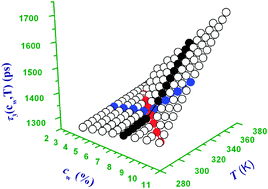Effect of water on glass transition in starch/sucrose matrices investigated through positron annihilation lifetime spectroscopy: a new approach
Abstract
Glass transition is studied through

* Corresponding authors
a Laboratoire “Eau, Molécules Actives, Macromolécules Activités”, AGROSUP-DIJON, Université de Bourgogne, 1 Esplanade Erasme, 21000 Dijon, France
b
Chimie Nucléaire, Institut Pluridisciplinaire Hubert Curien, UDS/IN2P3/CNRS, 23 rue du Loess, B.P. 28 670737 Strasbourg Cedex 2, France
E-mail:
skumars@barc.gov.in
Fax: 91 22 25505151
Tel: 91 22 25592858
Glass transition is studied through

 Please wait while we load your content...
Something went wrong. Try again?
Please wait while we load your content...
Something went wrong. Try again?
S. K. Sharma, A. Zaydouri, G. Roudaut and G. Duplâtre, Phys. Chem. Chem. Phys., 2011, 13, 19338 DOI: 10.1039/C1CP21243E
To request permission to reproduce material from this article, please go to the Copyright Clearance Center request page.
If you are an author contributing to an RSC publication, you do not need to request permission provided correct acknowledgement is given.
If you are the author of this article, you do not need to request permission to reproduce figures and diagrams provided correct acknowledgement is given. If you want to reproduce the whole article in a third-party publication (excluding your thesis/dissertation for which permission is not required) please go to the Copyright Clearance Center request page.
Read more about how to correctly acknowledge RSC content.
 Fetching data from CrossRef.
Fetching data from CrossRef.
This may take some time to load.
Loading related content
